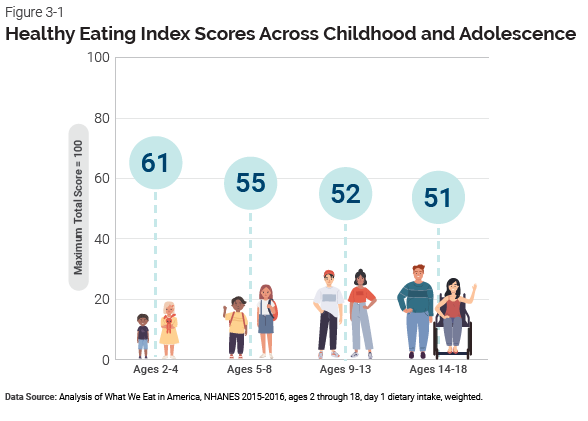By LT Dennis Anderson-Villaluz, MBA, RD, LDN, FAND, nutrition advisor, Office of Disease Prevention and Health Promotion
Establishing healthy dietary patterns early in life can provide young Americans with the foundation to continue those behaviors throughout later life stages. Unhealthy dietary patterns and inadequate physical activity in children and adolescents ages 2 to 18 contribute to overweight and obesity — as well as increasing the risk of chronic diseases such as type 2 diabetes and heart disease later in life.
Health professionals, parents, caregivers, and guardians are uniquely positioned to guide children during the earlier life stages and give them the opportunity to have a healthy start as they grow.
Measuring Dietary Quality Through the Healthy Eating Index
The Healthy Eating Index (HEI) measures diet quality based on the Dietary Guidelines on a scale of 0 to 100 — and the scores show that children and adolescents are not meeting the recommendations. The HEI score for children ages 2 to 4 is 61 out of 100. By the time children mature into adolescents (ages 14 to 18), the HEI score drops by 10 points. Compared to younger children, adolescents have lower intakes of vegetables, fruits, and dairy, and higher intake of added sugars.
These unhealthy dietary patterns early in life put Americans at a disadvantage as they transition into adulthood. That’s why it’s so important to support healthy eating habits early in life.
Encouraging Healthy Eating
The physical, mental, and emotional changes that occur as children transition from pre-school to school age and into adolescence come with diverse opportunities to support a healthy dietary pattern. It’s important for parents, guardians, and caregivers of young children to know that it can take up to 10 exposures before children accept a new type of food.
Some strategies to increase food acceptance include:
- Offering vegetables in different forms, such as cooked or raw
- Cutting fruits and vegetables into small, bite-sized pieces
- Pairing fruits or vegetables with a food the child enjoys, such as yogurt or peanut butter
Since children’s dietary patterns often resemble those of their household, there are multiple strategies that health professionals can share to support families.
- Shared meals — Early in childhood, shared meals have a tremendous impact on modeling healthy eating behaviors and dietary practices. Making nutrient-dense foods and beverages part of the normal household meal routine helps children observe and learn healthy behaviors that extend into adolescences and adulthood. Home meals also provide an opportunity for repeated exposure to a variety of new foods.
- Snacks — Promoting nutrient-dense foods for snacks, such as fruits and vegetables, can go a long way in shaping a child’s diet. For example, carrot sticks and hummus or apple slices and peanut butter are better snack options than chips, crackers, or cookies. Parents and caregivers can prepare healthy snacks such as pre-cut vegetables in advance, so that they’re easy for children to grab and eat.
- Meal decisions — Parents and caregivers can involve and guide children in age-appropriate meal decisions, as well as involve them in food shopping and cooking. When children feel more empowered in their food choices, they start to learn how to independently make healthy choices. This strategy can also apply when eating at restaurants or ordering delivery.
- Beverage selection — Decreasing consumption of sugar-sweetened beverages will help children and adolescents reduce their intake of added sugars and achieve a healthy dietary pattern. Beverages that contain no added sugars should be the primary choice. These include water and unsweetened fat-free or low-fat milk (including low-lactose or lactose-free options and fortified soy beverages). Fruit juice with no added sugars is also an option within recommended amounts.
Find Resources for Building Healthy Eating Habits
Youth have diverse calorie and nutrient needs based on age and patterns of growth, development, and physical activity. As guardians and health professionals support children to incorporate healthy eating strategies at home, it’s important to reinforce the impact of early dietary behaviors on future life stages. After all, every parent, guardian, or caregiver wants their children to have the best chance of success as they grow older.
There are additional materials that you can use to reinforce these messages:
- Find Dietary Guidelines resources to share with consumers
- Sign up for the Health.gov Food and Nutrition listserv
- Sign up for email updates about new resources related to the Dietary Guidelines — including future tools for health professionals scheduled to be released later in 2021




